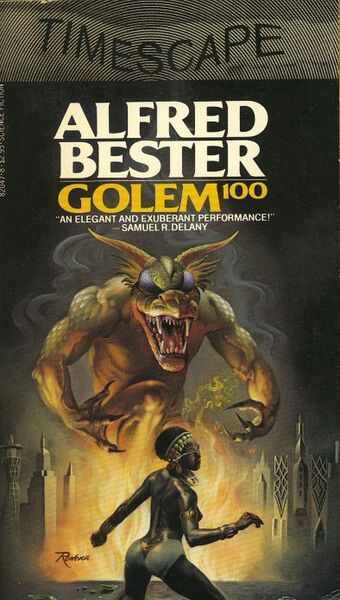From the Id
Golem100
By Alfred Bester

26 Jun, 2025
Alfred Bester’s 1980 Golem100 is a stand-alone near-future science fiction novel.
In the vast, overpopulated, resourced-strapped squalid megalopolis of tomorrow known as the Northeast Corridor, eight bored rich women — the “beeladies” — entertain themselves with innocent Satanism. What possible harm could come from dabbling in forces beyond their pampered ken?
Subadar Adida Ind’dni, confronted with a series of grotesque murders, might be able offer insight into the matter.
The Northeast Corridor AKA the Guff, once confined to New York City, stretches north to Canada, west to Pittsburgh, and south to the Carolinas. It is as short on water as it is rich in people. Bathing is a luxury and many folks are stinky1. A master perfumer like Blaise Shima is assured of respect and a predictable income.
Shima’s employers become concerned by Shima’s odd behavior, in particular unexplained disappearances. When Shima proves curiously adept at eluding tails, Gretchen Nunn is brought in to determine what exactly the chemist gets up to at night. The pattern she discovers is alarming: Shima’s meandering consistently leads him to the sites of the horrible murders Ind’dni is investigating.
Happily, for Shima and his employers, Shima is not a serial killer. Rather, when he is in a fugue state, he sniffs out impending horrific death. He is but a harbinger, not a deliberate instigator. How alarming for Nunn to find Shima at her door, bringing brutal murder in his wake.
Both Nunn and Shima survive their first encounter. Together with Ind’dni, they face a fearsome foe. The beeladies’ rites are more effective than the beeladies know. The beeladies have summoned the fearsome Golem100 from the collective unconscious.
Can an investigator, a chemist, and a detective confound the Golem100? Or will they simply unleash something worse?
~oOo~
Yeah, this is two days late. I mismanaged my calendar and scheduled two books on the same day. Whoops.
The bedtime story version of Bester’s life goes like this: once upon a time, Alfred Bester wrote two innovative SF novels, The Demolished Man and The Stars My Destination, and enough interesting short stories to fill a fat collection. Then he hit pause on his SF career2 so that he could focus on more lucrative work, such as editing Holiday magazine. When Holiday folded in the early 1970s, Bester returned to SF.
The intervening years had seen the rise and assimilation of the New Wave. SF was, as the publication of works like Dhalgren showed, more open to stylistic experimentation than it had been in the 1950s. This should have been a great time for Bester to resume writing. However what seems to have been a prodigious even by the standards of science fiction drinking habits—
He carried what must have been the world’s largest jock bag, crammed with newly-purchased bottles of wine that did not quite fit into the zippered closing.
—did Bester’s craft no favours. He didn’t let that prevent him from writing. Alas. Because his reputation had lived long past his talent, the results got published.
A fuller biography would yield a more complicated picture. For instance, Bester had to deal with various health challenges, which also affected his life and writing. Still, it’s not entirely inaccurate to divide his work into pre-hiatus classics and post-hiatus crap. Case in point, Golem100.
The novel is a meandering mess whose embrace of twee sexism and racism3 is not a plus. Bester lacks the control necessary to make the work interesting, or in the case of the stream of consciousness sections, readable. Certain elements of the worldbuilding are, to put it kindly, quaintly dated (even by the standards of 1980). Moreover, this is not the work to which you should turn for guidance on male-female relations. The only reason Golem100 was not the worst SF novel of 1980 is because of the happy coincidence that 1980 is also the year that Heinlein’s The Number of the Beast was published.
What makes Golem100 stand out amongst terrible SF novels (aside from the contrast with Bester’s earlier work) is that this isn’t some slapdash piece of hackwork hammered out to capitalize on a still-popular franchise from the 1940s. Bester’s effort is palpable. He makes some bold creative choices (and I’m not being sarcastic here). For instance, large swaths of the story are told in graphic form4. It’s possible the Bester of 1954 could have made it all work. The Bester in 1980 could not.
Golem100 is available here (Barnes & Noble), here (Bookshop US), here (Chapters-Indigo), and here (Words Worth Books).
I did not find Golem100 at either Bookshop UK or, interestingly enough, its publisher, iBooks.
1: USA delenda est.
2: This account is a gross simplification in that Bester’s SF career featured a number of hiatuses.
3: There was (and for all I know still is) a fashion for showing how society had moved past racism by having characters jokily refer to themselves and others with hilarious ethnic slurs.
4: Thanks to the graphic interludes, the novel was a much faster read than I had expected.
